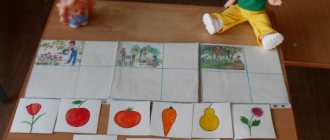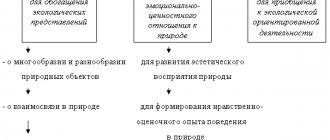Didactic game, its role in the development of preschool children
Elena Avilova
Didactic game, its role in the development of preschool children
Didactic games for preschool children
The main functions of a didactic game : it is a gaming method of teaching preschool , a form of education, an independent gaming activity, and a means of comprehensive education of a child’s personality.
Didactic games as a gaming method of teaching are considered in two forms:
- games-activities: the leading role belongs to the teacher, who uses a variety of game techniques, creates a game situation, introduces elements of competition, etc. The use of various components of game activities is combined with questions, instructions, explanations, and demonstrations.
— didactic games.
A didactic game as a form of teaching children contains two principles: educational (cognitive)
and gaming
(entertaining)
. The teacher is both a teacher and a participant in the game.
Didactic game as an independent gaming activity
is based on awareness of this process, if children show interest in the game, its rules and actions, if its rules have been learned by them.
Independent gaming activity does not exclude control from an adult, but is indirect in nature: for example, the teacher is an equal participant in the lotto game, receives a card and completes the task.
Didactic games in younger groups are considered as a method of teaching children role-playing games : the ability to take on a certain role , follow the rules of the game, and develop its plot . For example, in the didactic game “Put the doll to sleep,” the teacher teaches children a sequence of actions: neatly folding clothes, putting them to bed, singing lullabies. According to the rules of the game, children must select from the lying objects only those that are needed for sleep.
Didactic game as a means of comprehensive education of a child’s personality
Mental education. The content of didactic games forms in children the correct attitude to the phenomena of social life, nature, objects of the surrounding world, systematizes and deepens knowledge about the Motherland, the army, profession, and work activity. With the help of didactic games, the teacher teaches children to think independently and use the acquired knowledge in various conditions in accordance with the task.
Didactic games develop children's sensory abilities and speech: the vocabulary is replenished and activated, correct sound pronunciation is formed, coherent speech develops , and the ability to correctly express one's thoughts.
Moral education: the idea of caring for surrounding objects, toys as products of adult labor, norms of behavior, relationships with peers and adults, positive and negative personality traits is formed.
Labor education: respect and interest in the work of adults and a desire to work themselves are formed.
Aesthetic education: didactic material must meet hygienic and aesthetic requirements and evoke a desire to play with it .
Physical education: the game creates a positive emotional uplift and at the same time requires a certain tension in the nervous system. Particularly important are games with didactic toys , where develop and strengthen, and this affects mental development , preparing the hand for writing, for visual arts, i.e. for learning at school.
Main types of games
- playing with objects (toys, natural materials,
— printed board games,
- word games.
Games with objects: children perform tasks that require conscious memorization of the quantity and location of objects, finding the corresponding object, learn to compare, establish the similarities and differences of objects, become familiar with the properties of objects and their characteristics: color, size, shape, quality. As they master new knowledge about the subject environment, the tasks become more complicated: it is required to determine the subject by any one characteristic (color, shape, quality, purpose, etc.)
. Children of the younger group are given objects that differ sharply from each other in properties. In the middle group, they use items in which the difference between them is less noticeable.
Games with natural materials (plant seeds, leaves, flowers, pebbles, shells)
help to consolidate children’s knowledge about the natural environment around them, while forming thought processes
(analysis, synthesis, classification)
and fostering a love for nature and a caring attitude toward it.
Games with objects include plot -didactic games and dramatization games. In the plot-didactic game, children play certain roles: seller, buyer in games like “Shop”, etc. Drama games help clarify ideas about various everyday situations, about norms of behavior “What is good and what is bad?”
Printed board games: paired pictures, lotto, dominoes.
Selection of pictures in pairs: finding exactly the same ones among different pictures: two hats, identical in color, style, etc. Then the task becomes more complicated: combine the pictures not only by external features, but also by meaning: find two airplanes among all the pictures.
Selection of pictures based on a common feature: establishing a connection between objects is required. For example, in the game “What grows in the garden (forest, city?”), children select pictures with corresponding images of plants, correlate them with the place where they grow, and combine them according to one characteristic.
Memorizing the composition, number and location of pictures: for example, in the game “Guess which picture was hidden,” children must remember the contents of the pictures, and then determine which of them was turned upside down. These games are aimed at developing memory , memorization and recall.
Compiling cut-out pictures and cubes. Task: to teach children logical thinking, to develop their ability to form a whole object from individual parts. In younger groups, pictures are cut into 2-4 parts, in middle and older groups - into 8-10 parts. In this case, in the younger group, one object is depicted: a toy, a plant, items of clothing, etc. For older groups, a plot from familiar fairy tales is depicted.
Description, story about the picture showing actions and movements: the task is to develop not only children’s speech, but also imagination and creativity. In the younger group, the child resorts to imitation of movements and the voice of an animal. In older groups, more complex problems are solved: some children depict the action depicted in the picture, others guess who is depicted in the picture, what people are doing there, for example, firefighters putting out a fire, sailors sailing on the sea and etc.
Verbal games are based on the words and actions of the players . 4 groups of games:
1) games for developing the ability to identify essential features of objects and phenomena: “Guess it?”, “Shop”, “Yes - No”, etc.
2) games for developing the ability to compare and make correct conclusions: “Similar - not similar”, “Who will notice the most fables?”
3) games for developing the ability to generalize and classify objects according to various criteria: “Who needs what?”, “Name it in one word,” etc.
4) games for developing attention , quick wits, quick thinking, endurance, sense of humor: “Broken Phone”, “Paints”, “Flies - Doesn’t Fly”
Structure of a didactic game : teaching and educational task, game actions and rules.
Didactic task.
When defining a didactic task , one must, first of all, keep in mind what knowledge and ideas children have about nature, about surrounding objects, about social phenomena that should be acquired and consolidated by children, what mental operations should be developed , what personality traits can be formed ( honesty, modesty, observation, perseverance, etc.)
.
When defining a didactic task, one should avoid repetitions in its content, cliched phrases (“to develop attention, thinking, memory, etc.)
.
As a rule, these tasks are solved in every game, but in some games you need to pay more attention to the development of memory , in others - thinking, in others - attention. the didactic task accordingly . So the game “What has changed?” use for memory exercises, “Toy Store” - for the development of thinking , “Guess what you are planning” - observation, attention.
Game rules are designed to organize the actions and behavior of children.
Compliance with the rules of the game requires children to have a certain amount of willpower, the ability to deal with peers, and to overcome negative emotions that appear due to a negative result.
Play activities: their development depends on the teacher’s imagination. Sometimes children, preparing for the game, make their own suggestions: “Let’s hide it, and someone will look for it!”, “Let me choose the driver with a counting count!”
Recommendations for planning didactic games :
- planned and organized in both joint and independent activities of children, where they can play as they wish as a whole team, in small groups or individually;
— didactic games are short-term (10-20 min)
;
- provide children with the opportunity to play at different times of the day : in the morning before breakfast, between breakfast and class, during breaks between classes, during a walk, in the afternoon.
Prepared by Avilova E. S.
2017
The importance of didactic games for preschool children
The importance of didactic games for preschool children.
Maltseva E.A.
“Without play there is not and cannot be full-fledged mental development. A game is a huge bright window through which a life-giving stream of ideas and concepts flows into the child’s spiritual world. Play is the spark that ignites the flame of inquisitiveness and curiosity.” V.A. Sukhomlinsky.
Play is of particular importance in the lives of preschool children. Play is a means for children to learn about the world around them and prepare them for learning and work. In an active playful form, the child gains a deeper understanding of the phenomena of life, social relations of people, and labor processes. J. Bruner highly appreciates the importance of play for the intellectual development of preschool children, since during the game such combinations of material and such orientation in its properties can arise that can lead to the subsequent use of this material as tools for solving problems. Here we are talking about free experimentation with material, not bound by the solution of any specific problem, a kind of free constructive activity. In the game, more general mechanisms of intellectual activity develop.
In the game, the child acquires new knowledge, skills and abilities. Games that promote the development of perception, attention, memory, thinking, and the development of creative abilities are aimed at the mental development of the preschooler as a whole.
A didactic game is a collective, purposeful educational activity when each participant and the team as a whole are united in solving the main problem and focus their behavior on winning. A didactic game is an active educational activity involving simulation of the systems, phenomena, and processes being studied.
Didactic play is one of the important methods of active learning for children, and the game situation, as a rule, is taken based on the methodological basis of the lesson. The role of each participant in the game is clearly defined, there are rules and a certain rating system, and the game provides for a strict and step-by-step procedure. Didactic play is one of the important methods of active learning for children, and the game situation, as a rule, is taken based on the methodological basis of the lesson. The role of each participant in the game is clearly defined, there are rules and a certain rating system, and the game provides for a strict and step-by-step procedure.
In the theory and practice of preschool education, there is the following classification of didactic games:
a) with toys and objects;
b) desktop-printed;
c) verbal.
The characteristic features of didactic games are that they are created by adults for the purpose of teaching and raising children. However, created for didactic purposes, they remain games. The child in these games is attracted, first of all, by the game situation, and while playing, he quietly solves a didactic problem.
From understanding the meaning of didactic games, the following requirements for them follow:
• Each didactic game should provide exercises useful for training the memory and mental development of children in general, as well as their education.
• In a didactic game, there must be an exciting task, the solution of which requires mental effort and overcoming some difficulties.
• Didacticism in the game should be combined with entertainment, jokes, and humor.
• Passion for the game mobilizes mental activity and makes it easier to complete the task.
Each didactic game includes several elements, namely: a didactic task, content, rules and game actions. The main element of a didactic game is a didactic task. The main element of a didactic game is a didactic task. It is closely related to the lesson program. All other elements are subordinate to this task and ensure its implementation.
Thanks to the presence of game actions, didactic games used in the classroom make learning more entertaining, emotional, help increase children's voluntary attention, and create the prerequisites for a deeper mastery of knowledge, skills and abilities.
Literature:
- Abramenkova V.V. Play shapes a child’s soul // World of Psychology. – 1999. – No. 4. - With. 74-81.
- Arsentieva V.P. Play is the leading activity in preschool childhood.-Forum, 2009.- 144 p.
3. Bozhovich L.I. Personality and its formation in childhood. - Peter, 2009. - 237 p.
4. Smirnova E.O., Ryabkova I.A. Structure and options for a preschooler’s plot game // Psychological Science and Education. 2010. No. 3. – pp. 62-70
Methodological development “Didactic game as a means of teaching preschoolers”
Marziya Fazlyeva
Methodological development “Didactic game as a means of teaching preschoolers”
1. Relevance and significance of this problem
Play is the most accessible type of activity for children, a way of processing received impressions from the surrounding world. The game clearly reveals the child’s thinking and imagination, his emotionality, activity, which develops the need for communication.
An interesting game increases the child’s mental activity, and he can solve a more difficult problem than in class. Play is only one of the methods , and it gives good results only in combination with others: observation, conversations, reading, etc. By playing, children learn to apply their knowledge and skills in practice, to use them in different conditions. Play is an independent activity in which children interact with peers. They are united by a common goal, joint efforts to achieve, and common experiences. Play experiences leave a deep imprint on the child’s mind and contribute to the formation of good feelings, noble aspirations, and collective life skills. The game occupies a large place in the system of physical, moral, labor and aesthetic education. A child needs active activities that help improve his vitality, satisfy his interests and social needs.
The game is of great educational importance; it is closely related to learning in the classroom and observations of everyday life.
They learn to solve game problems on their own and find the best way to accomplish their plans. Use your knowledge and express it in words.
Often a game serves as an occasion for imparting new knowledge and broadening one’s horizons. With the development of interest in the work of adults, in public life, in the heroic deeds of people, children begin to have their first dreams of a future profession and a desire to imitate their favorite heroes. Everything makes games an important means of consciousness of the child’s direction, which begins to take shape in preschool childhood .
Thus, gaming activity is an urgent problem in the learning .
2.The purpose of this problem:
Determine the role of didactic games in teaching preschool children .
3.Tasks:
. Study the psychological foundations and features of the game;
. Reveal the essence of the concept of didactic game ;
. Analyze your experience in using didactic games in the educational process in a preschool educational institution.
. Systematize didactic games for children of different preschool ages .
MAIN PART
.The place and role of didactic games in the educational process
1. General characteristics of the didactic game
The main feature of didactic educational games . They are created by adults for the purpose of raising and educating children . But for at play , the educational value of a didactic game does not appear openly, but is realized through a game task, game actions, and rules.
As A. N. Leontyev noted, didactic games belong to the “boundary games ”, representing a transition to the non-game activity that they prepare. These games contribute to the development of cognitive activity, intellectual operations, which are the basis of learning . Didactic educational task - a learning task . Adults are guided by it when creating this or that didactic game , but they put it in a form that is entertaining for children.
A child is attracted to a game not by the educational task that is inherent in it, but by the opportunity to be active, perform game actions, achieve results, and win . However, if a participant in the game does not master the knowledge and mental operations that are determined by the learning task , he will not be able to successfully perform game actions or achieve results.
Thus, active participation, especially winning in a didactic game, depends on how much the child has mastered the knowledge and skills that are dictated by her learning task . This encourages the child to be attentive, remember, compare, classify, and clarify his knowledge. This means that the didactic game will help him learn something in an easy, relaxed way. This unintentional learning is called autodidactism .
Didactic games have existed for many centuries. Their first creator was a people who noticed an amazing feature of young children - their receptivity to learning through play , with the help of games and toys. Throughout the history of mankind, each nation has developed its own didactic games , unique didactic toys that have become part of its culture. The content of didactic games and toys reflected the features of the national character, nature, history, life of a particular people.
Folk didactic games provide a relationship between educational and training influences, taking into account the age-related psychophysiological characteristics of the child. Folk didactic games are characterized by clearly expressed educational emotional and cognitive content, embodied in playful form, imagery, and dynamic game actions. The content of the game is event-based, i.e., it reflects some incident or event that evokes a certain emotional response in the child and enriches his social experience.
In Russian folk pedagogy there are didactic games and toys intended for children of different ages: from early childhood to school age. They enter a child’s life very early - in the first year of life.
For older children, Russian folk pedagogy intends didactic games , which provide the opportunity to develop activity, dexterity, initiative, and ingenuity. for preschoolers to move and communicate with peers is expressed
Over time, folk games are subject to changes made by the children themselves (updating the content, complicating the rules, using different gaming material). Variants of games are created by practicing teachers. Based on the ideas inherent in folk games , scientists create new didactic games and offer entire systems of such games.
The tradition of widespread use of didactic games for the purpose of raising and teaching children , established in folk pedagogy, was developed in the works of scientists and in the practical activities of many teachers. Essentially, in every pedagogical system of preschool education, didactic games occupied and still occupy a special place.
The author of one of the first pedagogical systems of preschool education, Friedrich Froebel, was convinced that the task of primary education was not learning in the ordinary sense of the word, but organizing play. While remaining a game, it must be imbued with a lesson. F. Frebel developed a system of didactic games , which represents the basis of educational work with children in kindergarten.
This system includes didactic games with different toys and materials, arranged strictly sequentially according to the principle of increasing complexity of learning tasks and game actions. An obligatory element of most didactic games were poems , songs, rhyming sayings, written by F. Froebel and his students with the aim of enhancing the educational impact of games .
Another world-famous system of educational games , authored by Maria Montessori, also received mixed reviews. In determining the place of play in the educational process of a kindergarten, M. Montessori is close to the position of F. Frebel: games should be educational , otherwise it is an “empty game ” that does not have an impact on the development of the child. For educational games and activities, she created interesting didactic materials for sensory education.
The didactic game has its own structure, which includes several components. Let's consider these components:
Educational ( didactic )
task is the main element
of the didactic game , to which all others are subordinated. For children, the learning task is formulated as a game task. For example, in the game “Recognize an object by sound,” the educational task is as follows : to develop auditory perceptions, teach children to correlate sound with an object . And children are offered the following game task: listen to the sounds that different objects make, and guess these objects by sound.
Thus, the game task reveals the “program” of game actions. The game task is often included in the name of the game. Play actions are ways of showing a child’s activity for play purposes: putting his hand in the “wonderful bag”, feeling for a toy, describing it, etc.
For children of early and primary preschool age, a didactic game is fascinated by the process of the game, but they are not yet interested in the result. Therefore, the game actions are simple and of the same type.
For children of middle and senior preschool age, more complex play activities are provided, usually consisting of several play elements. Children 5-6 years old, participating in a plot-based didactic game , perform a set of game actions related to the implementation of a certain role.
In the games of older preschoolers, gaming actions of a mental nature predominate: show observation, compare, recall what was previously learned, classify objects according to certain characteristics, etc.
So, depending on the age and level of development of children, game actions in the didactic game .
The rules ensure the implementation of the game content. They make the game democratic: all participants in the game obey them.
between the learning task , game actions and rules. The learning task determines the game actions, and the rules help to carry out the game actions and solve the problem.
In preschool pedagogy, all didactic games can be divided into three main types: games with objects, board-printed and word games.
Games with objects
These games use toys and real objects. By playing with them , children learn to compare, establish similarities and differences between objects . The value of games is that with their help children become familiar with the properties of objects and their characteristics : color, size, shape, quality.
The games solve problems involving comparison, classification, and establishing sequence in solving problems.
in educational games . They clearly express color, shape, purpose, size, and the material from which they are made. This allows the teacher to train children in solving certain didactic tasks , for example, selecting all the toys made of wood.
Using didactic games with similar content, the teacher manages to arouse children’s interest in independent play and suggest to them the idea of the game with the help of selected toys.
Board-printed games
Printed board games are an interesting activity for children. They come in a variety of types: paired pictures, lotto, dominoes.
Word games
Word games are built on the words and actions of the players . In such games, children learn , based on existing ideas about objects, to deepen their knowledge about them, since in these games it is necessary to use previously acquired knowledge in new connections, in new circumstances.
Children independently solve various mental problems; describe objects, highlighting their characteristic features; guess from the description.
With the help of verbal games, children develop a desire to engage in mental work.
2. Using didactic games in teaching preschoolers
In the pedagogical process of a preschool institution, didactic play acts primarily as an independent activity of children, which determines the nature of its management.
In didactic games, children are given certain tasks, the solution of which requires concentration , attention, mental effort, the ability to comprehend the rules, sequence of actions, and overcome difficulties. They promote the development of sensations and perceptions in preschoolers , the formation of ideas, and the acquisition of knowledge. These games make it possible to teach children a variety of economical and rational ways to solve certain mental and practical problems. This is their developing role.
The didactic game helps solve the problems of moral education and develop sociability in children. The teacher places children in conditions that require them to be able to play together , regulate their behavior, be fair and honest, compliant and demanding.
Successful management of didactic games , first of all, involves selecting and thinking through their program content, clearly defining tasks, determining their place and role in the holistic educational process, and interaction with other games and forms of education . It should be aimed at developing and encouraging children’s cognitive activity, independence and initiative, their use of different ways to solve game problems, and should ensure friendly relations between participants and a willingness to help their comrades.
The development of interest in didactic games and the formation of play activities in children is achieved by the fact that the teacher sets increasingly more complex tasks for them and is in no hurry to suggest play actions. The play activity of preschoolers becomes more conscious; it is more aimed at achieving a result, and not at the process itself. But the management of the game should be such that children retain the appropriate emotional mood, ease, so that they experience the joy of participating in it and a sense of satisfaction from solving the tasks.
In each group, the teacher outlines a sequence of games that become more complex in content, didactic tasks , game actions and rules. Individual, isolated games can be very interesting, but using them outside the system cannot achieve educational and developmental results. Therefore, it is necessary to clearly define the interaction between teaching direct educational activities and in the didactic game .
It should be taken into account that in a didactic game, the correct combination of clarity, the words of the teacher and the actions of the children themselves with toys, play aids, objects, pictures, etc. is necessary.
With the help of verbal explanations and instructions, the teacher directs the children's attention, organizes, clarifies their ideas, and expands their experience. His speech helps to enrich the vocabulary of preschool children , master various forms of learning , and contribute to the improvement of play actions. Detailed and verbose explanations, frequent comments and instructions, and mistakes are unacceptable, even if they are caused by the desire to straighten the game. This kind of explanation and remarks tear the living fabric of play activity, and children lose interest in it.
When leading games , the teacher uses a variety of means of influence on preschoolers . For example, acting as a direct participant in the game, he directs the game unnoticed by them, supports their initiative, and empathizes with them the joy of the game. Sometimes the teacher talks about an event, creates an appropriate gaming mood and maintains it during the game. He may not be involved in the game, but as a skillful and sensitive director, preserving and protecting its independent character, he guides the development of game actions, the implementation of the rules and, unnoticed by the children, leads them to a certain result. When supporting and encouraging children's activities, the teacher most often does this not directly, but indirectly: he expresses surprise, jokes, uses various kinds of playful surprises, etc.
We must remember, on the one hand, about the danger of overly reinforcing the teaching moments , weakening the beginning of the game, giving the didactic game the character of a direct educational activity , and, on the other hand, being carried away by the entertainment, escaping from the task of learning .
The development of the game is largely determined by the pace of children’s mental activity, the greater or lesser success of their performance of game actions, the level of assimilation of the rules, their emotional experiences, and the degree of enthusiasm. During the period of assimilation of new content of game actions, rules and the beginning of the game, its pace is naturally slower. Later, when the game unfolds and the children get carried away, its pace quickens. By the end of the game, the emotional upsurge seems to subside and the pace of the game slows down again. Avoid excessive slowness and unnecessary acceleration of the tempo of the game. The fast pace sometimes causes confusion in children, uncertainty, untimely completion of game actions, and violation of rules. Preschoolers do not have time to get involved in the game and become overexcited. The slow pace of the game occurs when overly detailed explanations are given and many small comments are made. This leads to the fact that game actions seem to move away, the rules are introduced untimely, and children cannot be guided by them, commit violations, and make mistakes. They get tired faster, monotony reduces emotional uplift.
When leading a didactic game , the teacher uses various forms of organizing children. If close contact is necessary, then preschoolers are seated on chairs placed in a circle or semicircle, and the teacher sits in the center. In a didactic game, there is always the possibility of unexpected expansion and enrichment of its concept in connection with the initiative, questions, and suggestions shown by the children. The ability to keep the game within a set time is a great art. The teacher compresses time primarily by shortening his explanations. Clarity and brevity of descriptions, stories, and remarks are a condition for the successful development of the game and the completion of the tasks being solved.
When finishing the game, the teacher should arouse children’s interest in continuing it and create a joyful prospect.
A didactic game as one of the forms of learning is carried out during the time allocated in the mode of direct educational activities . The game can alternate with direct educational activities , when it is necessary to strengthen the independent activity of children, organize the application of what has been learned in gaming activities, summarize, and generalize the material studied.
Didactic games are held in a group room, in a hall, on a plot, in a forest, in a field, etc. This ensures broader motor activity for children, a variety of impressions, and spontaneity of experiences and communication.
Children of older preschool age are already capable of making independent conclusions, conclusions, and generalizations. Didactic games provide invaluable assistance for the development of these abilities .
The tasks of many games designed for children of the older group involve the cooperation of children, the joint selection of pictures, toys, routes, their comparison, discussion of the characteristics of the subject , methods of their classification. This helps to activate children’s existing knowledge and ways of applying it in real and simulated situations. In the process of jointly completing a task, there is a mutual exchange of knowledge and experience.
Many games involve mutual control and evaluation of the actions and decisions of peers. The role of the educator is mainly to help the child make the right choice, support and activate the positive influence of children on each other, and prevent or neutralize the negative one.
Conclusion
Play develops in a child the ability to identify what is essential and characteristic in the environment, and helps him to understand the phenomena of reality more deeply and fully. The game promotes the development of creative imagination, which is necessary for the child’s subsequent educational and work activities.
The game develops strong-willed qualities in children: the ability to subordinate their actions to certain rules, to coordinate their behavior with the tasks of the whole team. Finally, in play, the child masters moral norms and rules of behavior, which play a decisive role in the formation of his personality.
Play is an important means of mental education. Reproducing various life events and episodes from fairy tales, the child reflects on what he saw, what was read and told to him. Thus, through play, children’s interest in different professions is consolidated and deepened, and respect for work is fostered.
Proper management of games is crucial in the development of a child’s psyche and in the formation of his personality.
Literature
1. Artemova L. V. The world around us in didactic games for preschoolers . - M., 2007.
2. Bondarenko A.K. Didactic games in kindergarten . - M., 1990. - 280 p.
3. Vasilyeva M. A. Management of children’s games in preschool institutions . - M., 2009.
4. Gerbova V.V. Raising children. - M., 2009.
5. Grishina G. N. Favorite children's games. - M., 1997.
6. Menzheritskaya D.V. To the teacher about children's games. - M., 2003.
7. Pidkosisty P.I. Game technology in education and development . - M., 2005.
8. Usova A.P. The role of games in raising children. - M., 2007.
9. Sorokina A.I. Didactic games in kindergarten . - M., 2010.
10. Huizing I. A man playing . - M., 1999.
11. Shmakov S. A. Her Majesty the Game . - M., 1992. - 230 p.







